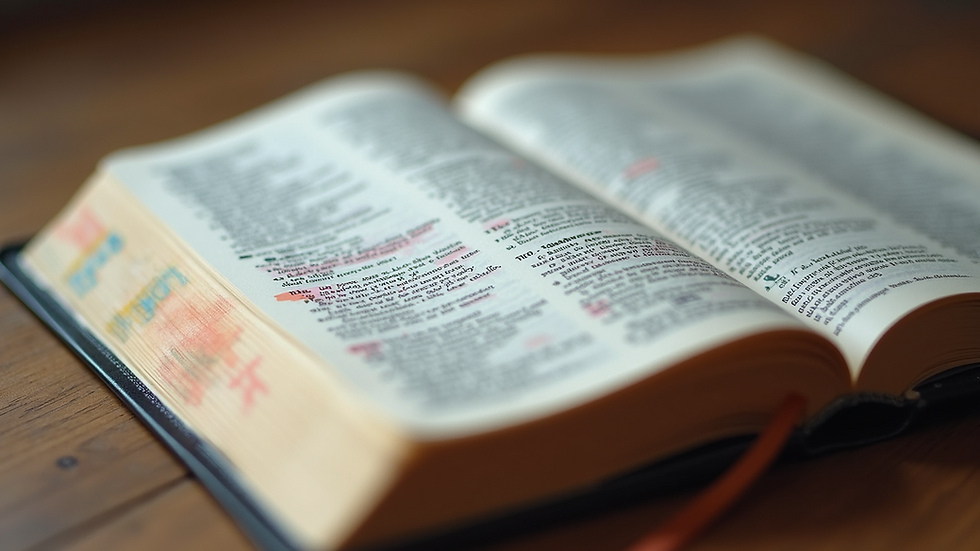What Percentage of Americans Own a Bible? A Closer Look at the Statistics
- Joy Creative Bibles

- Feb 18
- 4 min read
The Bible is more than just a book; it is a cornerstone of American culture that has influenced beliefs, values, and traditions for centuries. With surveys revealing how many Americans own a Bible, the statistics provide a window into our society's changing dynamics regarding faith and spirituality. This post explores the statistics surrounding Bible ownership in the United States and examines the factors influencing these numbers.
The Historical Context of Bible Ownership
To grasp today’s Bible ownership statistics, one must first recognize the Bible’s long history in America. Following the printing press's invention, the Bible was one of the first texts printed in the United States. This early availability led to its integration into American culture.
Many families pass down Bibles across generations, containing handwritten notes, family trees, and personal stories. The act of owning a Bible often extends beyond its religious significance, representing a connection to family heritage. For example, a study indicated that 64% of Americans feel that their Bible is a crucial part of their family history.
Current Statistics on Bible Ownership
Recent data sheds light on the current state of Bible ownership. A 2021 report from the American Bible Society found that approximately 87% of American households possess at least one Bible. This reflects a decrease from earlier studies where ownership rates were above 90%.
Notably, younger adults, particularly those aged 18 to 29, are less likely to own a Bible. Only 56% of this age group reported owning one compared to 90% of individuals over 50. This shift highlights generational trends and changing attitudes towards religion.
Factors Influencing Bible Ownership
Several key factors shape Bible ownership rates among different groups:
Religious Affiliation: Christians are significantly more likely to own a Bible. Surveys indicate that 93% of evangelicals own a Bible, while only 58% of those identifying as non-religious have one.
Cultural Trends: The rise of secularism impacts Bible ownership, especially among younger individuals. With technology advancing, many turn to digital Bible apps instead of physical copies. Reports show that 29% of Americans use online resources for Bible study.
Education and Exposure: Education is linked to higher rates of Bible ownership. People actively participating in religious education or community services often possess a Bible. For example, 72% of individuals attending church regularly reported owning one, compared to only 38% of those who do not attend services.
The Importance of Bible Ownership
Owning a Bible signifies more than simply possessing a book. For many, it represents guidance, comfort, and spiritual connection. Beyond personal use, Bibles often become focal points for discussions about faith and morals within families. Families that read the Bible together foster deeper conversations about life values, which can significantly shape children's moral compass.
In numerous households, the family Bible acts as an heirloom. It's common to find entries of births, marriages, and deaths recorded within its pages, making it a tangible link to family history and heritage.
Regional Differences in Bible Ownership
Bible ownership varies significantly across different regions in the U.S. This is particularly evident in the "Bible Belt," which includes states like Texas, Tennessee, and Georgia, where ownership rates exceed 90%. In contrast, states with more urban populations, such as New York and California, where secularism tends to be stronger, have lower ownership rates of around 75%.
This distinction is important, as it reflects the diverse cultural landscape of faith across the country. Understanding these regional differences can enrich discussions about the role of religion and spirituality in various communities.
Shifts Over Time
As we evaluate Bible ownership trends, we note a gradual decline over the past few decades. In the early 1990s, surveys showed that over 90% of Americans owned a Bible. However, the current figure of 87% suggests a pattern of diminished physical engagement with religious texts, particularly among younger generations.
Despite this decline in ownership, it does not necessarily denote a lack of interest in spirituality. Many younger individuals are exploring their beliefs through digital platforms rather than physical texts, indicating a shift in how faith is expressed.
The Future of Bible Ownership
Looking forward, the landscape of Bible ownership appears poised for further change. The rise of technology and access to online resources allows people to engage with scripture without owning a physical copy, leading many to explore other forms of spiritual expression.
As new generations seek relevant ways to connect with their beliefs, traditional Bible ownership may continue to decline. However, the enduring relevance of the Bible in teaching values and fostering personal connection suggests it will remain integral to American culture, even in evolving forms.
Final Thoughts
In summary, about 87% of American households currently own a Bible, illustrating its ongoing importance in our society. Although ownership has declined over the years, particularly among youthful demographics, the factors influencing this trend reveal a complex interplay between technology, culture, and personal values. Understanding these dynamics can provide insight into the Bible's place in modern American life, highlighting both the challenges and the opportunities presented by changing times.



header.all-comments